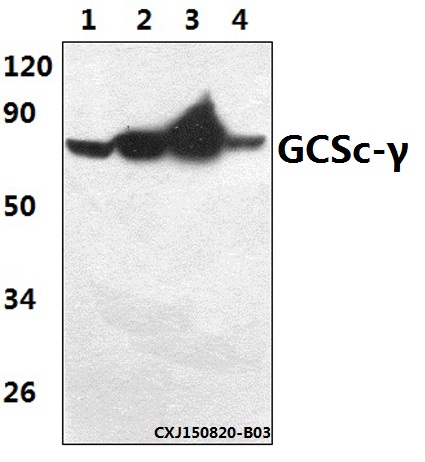Product Name :
GCSc-γ (E315) polyclonal antibody Background :
The GCLC gene consists of 16 exons and encodes the 636 amino acid protein γ-GCSc (γ-glutamylcysteine synthetase heavy subunit), also designated γ-Lglutamate- L-cysteine ligase catalytic subunit (GLCLC). γ-GCSc is expressed in hemocytes, brain, liver and kidney. γ-GCSc associates with a regulatory or modifier subunit, γ-GCSm (γ-glutamylcysteine synthetase light subunit), to form a heterodimer, γ-GCS. γ-GCS is the first enzyme involved and the rate determining step in glutathione iosynthesis. Oxidants, cadium and methyl mercury upregulate the transcription of γ-GCS. H2O2 regulation depends on the Yap1 protein and the presence of glutamate, glutamine and lysine. Cadium regulates transcription through proteins Met-4, Met-31 and Met-32. Cbf1, a DNA binding protein, inhibits transcription of γ-GCS. Product :
Rabbit IgG, 1mg/ml in PBS with 0.02% sodium azide, 50% glycerol, pH7.2 Storage&Stability :
Store at 4°C short term. Aliquot and store at -20°C long term. Avoid freeze-thaw cycles. Specificity :
GCSc-γ (E315) polyclonal antibody detects endogenous levels of GCSc-γ protein. Immunogen :
Synthetic peptide, corresponding to amino acids 300-350 of Human GCSc-γ. Conjugate :
Unconjugated Modification :
Unmodification
GCSc-γ (E315) polyclonal antibody Background :
The GCLC gene consists of 16 exons and encodes the 636 amino acid protein γ-GCSc (γ-glutamylcysteine synthetase heavy subunit), also designated γ-Lglutamate- L-cysteine ligase catalytic subunit (GLCLC). γ-GCSc is expressed in hemocytes, brain, liver and kidney. γ-GCSc associates with a regulatory or modifier subunit, γ-GCSm (γ-glutamylcysteine synthetase light subunit), to form a heterodimer, γ-GCS. γ-GCS is the first enzyme involved and the rate determining step in glutathione iosynthesis. Oxidants, cadium and methyl mercury upregulate the transcription of γ-GCS. H2O2 regulation depends on the Yap1 protein and the presence of glutamate, glutamine and lysine. Cadium regulates transcription through proteins Met-4, Met-31 and Met-32. Cbf1, a DNA binding protein, inhibits transcription of γ-GCS. Product :
Rabbit IgG, 1mg/ml in PBS with 0.02% sodium azide, 50% glycerol, pH7.2 Storage&Stability :
Store at 4°C short term. Aliquot and store at -20°C long term. Avoid freeze-thaw cycles. Specificity :
GCSc-γ (E315) polyclonal antibody detects endogenous levels of GCSc-γ protein. Immunogen :
Synthetic peptide, corresponding to amino acids 300-350 of Human GCSc-γ. Conjugate :
Unconjugated Modification :
Unmodification
-
 Western blot (WB) analysis of GCSc-γ (E315) polyclonal antibody at 1:500 dilution Lane1:HepG2 whole cell lysate(40ug) Lane2:NIH-3T3 whole cell lysate(40ug) Lane3:PC12 whole cell lysate(40ug) Lane4:A549 whole cell lysate(40ug)
Western blot (WB) analysis of GCSc-γ (E315) polyclonal antibody at 1:500 dilution Lane1:HepG2 whole cell lysate(40ug) Lane2:NIH-3T3 whole cell lysate(40ug) Lane3:PC12 whole cell lysate(40ug) Lane4:A549 whole cell lysate(40ug)
Protection of cyanidin-3-glucoside against oxidative stress induced by acrylamide in human MDA-MB-231 cells.
PMCID: Pubmed No.:23685245
Oleanolic acid improves hepatic insulin resistance via antioxidant, hypolipidemic and anti-inflammatory effects
PMCID: Pubmed No.:23791844
Saponins from Aralia taibaiensis attenuate D-galactose-induced aging in rats by activating FOXO3a and Nrf2 pathways
PMCID: Pubmed No.:24669284
Saponins from Aralia taibaiensis attenuate D-galactose-induced aging in rats by activating FOXO3a and Nrf2 pathways
PMCID: Pubmed No.:24669284
Neuroprotective Effects of Tetramethylpyrazine against Dopaminergic Neuron Injury in a Rat Model of Parkinson's Disease Induced by MPTP
PMCID: Pubmed No.:24719552
Curcumin ameliorates cognitive deficits heavy ion irradiation-induced learning and memory deficits through enhancing of Nrf2 antioxidant signaling pathways
PMCID: Pubmed No.:25159739
Curcumin ameliorates cognitive deficits heavy ion irradiation-induced learning and memory deficits through enhancing of Nrf2 antioxidant signaling pathways
PMCID: Pubmed No.:25159739
Saponins from Aralia taibaiensis attenuate D-galactose-induced aging in rats by activating FOXO3a and Nrf2 pathways
PMCID: Pubmed No.:24669284
Saponins from Aralia taibaiensis attenuate D-galactose-induced aging in rats by activating FOXO3a and Nrf2 pathways
PMCID: Pubmed No.:24669284
Neuroprotective Effects of Tetramethylpyrazine against Dopaminergic Neuron Injury in a Rat Model of Parkinson's Disease Induced by MPTP
PMCID: Pubmed No.:24719552
Mangiferin Upregulates Glyoxalase 1 Through Activation of Nrf2/ARE Signaling in Central Neurons Cultured with High Glucose
PMCID: Pubmed No.:27318675
Desflurane Preconditioning Protects Against Renal Ischemia–Reperfusion Injury and Inhibits Inflammation and Oxidative Stress in Rats Through Regulating the Nrf2-Keap1-ARE Signaling Pathway
PMCID: Pubmed No.:32308368
Bioworld Biotech only provide peptides for our antibodies and do not provide additional peptide customization services.
Price/Size :
USD 368/1mg/vial
Tips:
For phospho antibody, we provide phospho peptide(0.5mg) and non-phospho peptide(0.5mg).Describe :
Blocking peptides are peptides that bind specifically to the target antibody and block antibody binding. These peptide usually contains the epitope recognized by the antibody. Antibodies bound to the blocking peptide no longer bind to the epitope on the target protein. This mechanism is useful when non-specific binding is an issue, for example, in Western blotting (WB) and Immunohistochemistry (IHC). By comparing the staining from the blocked antibody versus the antibody alone, one can see which staining is specific; Specific binding will be absent from the western blot or IHC performed with the neutralized antibody.Formula:
Synthetic peptide was lyophilized with 100% acetonitrile and is supplied as a powder. Reconstitute with 0.1 ml DI water for a final concentration of 10 mg/ml.The purity is >90%,tested by HPLC and MS.
Storage:
The freeze-dried powder is more stable. For short time at 2-8°C. For long term storage store at -20°C.
Note :
This product is for research use only (RUO only). Not for use in diagnostic or therapeutic procedures.
 GCSc-γ (E315) polyclonal antibody
GCSc-γ (E315) polyclonal antibody  Datasheet
Datasheet COA
COA MSDS
MSDS SHIP
SHIP